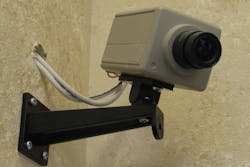Study: Over 90 percent of surveillance deployments involve IT departments
As the convergence of IT and physical security has accelerated in recent years, it should come as little to surprise that IT managers are having a greater influence these days on security purchasing decisions. In fact, according to the results of a study conducted by Enterprise Strategy Group (ESG) on behalf of Axis Communications, 91 percent of organizations currently using video surveillance technology reported that their IT department manages or supports these deployments. Just three years ago, however, just 52 percent of video surveillance deployments were supported by IT.
Additionally, of the IT professionals polled in the study who were involved with video surveillance at mid- to enterprise-sized organizations, 47 percent said that their department is the “most responsible” for setting surveillance strategy and making final purchasing decisions, followed by senior management (23 percent), physical security/loss prevention (9 percent), compliance (9 percent), facilities (5 percent), and legal (5 percent).
“Given the inevitable shift from outdated analog CCTV to superior IP video systems, a number of technical factors, such as network infrastructure requirements, bandwidth usage and data storage consumption, are moving surveillance decisions beyond the realm of physical security and directly impacting IT,” ESG Senior Principal Analyst Jon Oltsik said in a statement. “The ESG research indicates those IT departments that include surveillance requirements in their IT strategy and leverage video for business process improvement tend to maximize the benefits of surveillance investments while reducing unnecessary operations overhead.”
The study also identified unique best practices for video surveillance when IT is involved including:
• Leveraging surveillance for business intelligence (BI). Eighty-percent of IT pros were found to use video footage for BI applications. Use cases include identifying operational efficiencies (58 percent), production or process control (51 percent), inventory control (50 percent), identifying traffic patterns (49 percent) and employee training (47 percent).
• Using BI to justify IP video investment. For those using surveillance for BI across the organization, 88 percent said it helps justify IP video technology and infrastructure investments.
• Utilizing data retention and cloud replication procedures. Forty-six percent dedicate 11-25 terabytes (TB) for surveillance data storage, and 35 percent between 6-10 TB. Additionally, counter to the traditional physical security mindset for storing video surveillance, 40 percent of IT respondents leverage cloud-based services to store video data.
• Creating a technology migration plan. For organizations that use a mix of IP video and analog CCTV, 68 percent have a formal plan to migrate equipment to IP-based systems.
Despite the fact that IT is becoming more heavily involved in video deployments, the study also found that there is still a need for education regarding IP video design and implementation. Half of the top 10 challenges cited with current surveillance implementations are IT-related, according to the research.
The top three are:
• The search and retrieval of footage (30 percent)
• The impact on network bandwidth (29 percent)
• The difficulty of IT to manage growing volumes of video surveillance (25 percent).
“We’ve seen much more IT involvement as the industry shifts to IP video – but ESG’s research was even higher than anticipated,” said Fredrik Nilsson, general manager, Axis Communications. “IT’s influence can positively affect network design, storage and business intelligence best practices, and the research points to opportunities for integrators to work together with their IT and physical security contacts to overcome the challenges of IP video with proper system configuration and expectation setting.”



